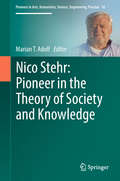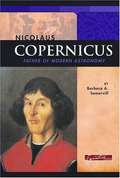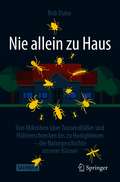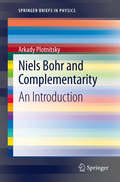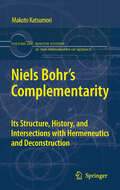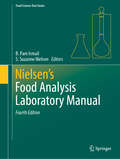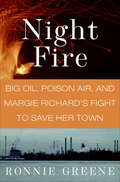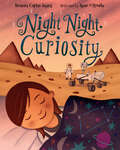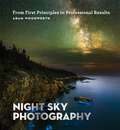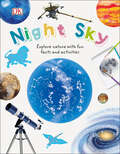- Table View
- List View
Nickelgruppe: Eine Reise durch das Periodensystem (essentials)
by Hermann SiciusHermann Sicius stellt ausf#65533;hrlich die Elemente der zehnten Nebengruppe (Nickel, Palladium, Platin und Darmstadtium) vor, deren physikalische und chemische Eigenschaften relativ #65533;hnlich sind. Nickel wurde 1751 entdeckt, Palladium 1803, und Platin war zumindest in legierter Form schon in Alt#65533;gypten bekannt. Auch beim Elementenpaar Palladium und Platin erkennt man noch die Auswirkung der Lanthanoidenkontraktion. Die jeweiligen physikalischen Eigenschaften dieser zwei Elemente unterscheiden sich jedoch schon merklich, nicht aber die chemischen. Die Eigenschaften des Nickels dagegen weichen von denen der zwei ,,edlen" Platinmetalle Palladium und Platin deutlich ab. So zeigt Nickel ein negatives Normalpotential sowie niedrigere Dichten, Schmelz- und Siedepunkte. Bei Nickel ist die Oxidationsstufe +2 die stabilste, Palladium und Platin treten jeweils mit der Oxidationsstufe +2 und +4 auf und Iridium mit +4. 1994 konnten die ersten Atome des Darmstadtiums erzeugt werden.
Nico Bloembergen: Master of Light (Springer Biographies)
by Rob HerberThis biography is a personal portrait of one of the best-known Dutch physicists, Nicolaas Bloembergen. Born in 1920 in Dordrecht, Bloembergen studied physics in Utrecht, leaving after World War II for the United States, where he became an American citizen in 1958. At Harvard University, he pioneered nuclear magnetic resonance (NMR, used in chemistry and biology for structure identification; moreover leading to MRI), laser theory and nonlinear optics. In 1978 he was awarded the Lorentz Medal for his contribution to the theory of nonlinear optics (used in fiber optics), and in 1981 he received the Nobel Prize for physics, along with Arthur Schawlow and Kai Siegbahn. The book is based on numerous conversations with Nicolaas Bloembergen himself, his wife Deli Brink, his family, and colleagues in science. It describes his childhood and study in Bilthoven and Utrecht, the first postwar years at Harvard, the discoveries of masers and lasers, and the award of the Nobel Prize. It also delves into Bloembergen's involvement in American politics, particularly his role in Ronald Reagan's controversial "Star Wars" program.
Nico Stehr: Pioneer in the Theory of Society and Knowledge (Pioneers in Arts, Humanities, Science, Engineering, Practice #16)
by Marian T. AdolfThis unique volume brings together a selection of the most important texts of Nico Stehr for the first time and puts them in dialogue with original research that draws on his prolific work. Covering five decades of pioneering sociological research on the theory of society and knowledge, the book introduces the reader to Stehr’s seminal inquiries into the economic, political and social role of knowledge. Original concepts, such as his groundbreaking studies on the Knowledge Society, are introduced as the volume traces Stehr’s pursuit of social scientific research as a source of practical knowledge for modern society.The book comprises three parts devoted to the many facets and the remarkable range of Nico Stehr’s oeuvre. Part 1 provides an introduction to the significance of his pioneering work and career. Part 2 demonstrates the practical application of Nico Stehr’s research as seen through the eyes of eminent scholars. Part 3 presents a selection of the milestones of his publications.
Nicolaus Copernicus: Father of Modern Astronomy
by Barbara A. SomervillA biography profiling the life and controversial ideas of Nicolaus Copernicus, the founder of modern astronomy who through his observations of the stars and planets, discovered that the sun was the center of the universe, which challenged the teachings of the Roman Catholic Church. Includes source notes and timeline.
Nicotinic Receptors in the Nervous System (Frontiers in Neuroscience)
by Edward D. LevinFeaturing a unique approach, Nicotinic Receptors in the Nervous System provides integrated coverage of research on neuronal nicotinic systems relevant to smoking addiction and cognitive dysfunction. By bringing together molecular and neurochemical applications, the book provides the key to understanding function and dysfunction of nicotinic systems and how they are significant for disease, addiction, and the development of novel drug treatments. The book presents readers with the basic mechanistic background for these treatments as well as the functional assessment necessary to determine therapeutic effects.
Nie allein zu Haus: Von Mikroben über Tausendfüßer und Höhlenschrecken bis zu Honigbienen – die Naturgeschichte unserer Häuser
by Rob DunnDieses Buch lässt einen das eigene Zuhause mit anderen Augen sehen.Selbst wenn die Böden blitzsauber sind und das Haus leer erscheint, sind unsere Häuser voller Leben. In Nie allein zu Haus stellt uns der Biologe Rob Dunn die fast 200.000 Arten vor, die bei uns zu Hause leben, von den ägyptischen Mehlmotten in unseren Schränken über die Kamelgrillen in unseren Kellern bis hin zum Laktobazillus, der auf unseren Küchenarbeitsplatten lebt. Während wir davon besessen sind, unsere Häuser zu sterilisieren und unsere Räume von der Natur zu trennen, bauen wir unbewusst einen völlig neuen Spielplatz für die Evolution. Der neue Lebensraum beeinflusst die Organismen, die mit uns leben, bringt einige dazu gefährlicher zu werden, und untergräbt gleichzeitig jene Arten, die unserem Körper gut tun oder uns helfen, bedrohlichere Organismen in Schach zu halten.
Niels Bohr (SparkNotes Biography Guide)
by SparkNotesNiels Bohr (SparkNotes Biography Guide) Making the reading experience fun! SparkNotes Biography Guides examine the lives of historical luminaries, from Alexander the Great to Virginia Woolf. Each biography guide includes:An examination of the historical context in which the person lived A summary of the person&’s life and achievements A glossary of important terms, people, and events An in-depth look at the key epochs in the person&’s career Study questions and essay topics A review test Suggestions for further reading Whether you&’re a student of history or just a student cramming for a history exam, SparkNotes Biography guides are a reliable, thorough, and readable resource.
Niels Bohr and Complementarity
by Arkady PlotnitskyThis book offers a discussion of Niels Bohr's conception of "complementarity," arguably his greatest contribution to physics and philosophy. By tracing Bohr's work from his 1913 atomic theory to the introduction and then refinement of the idea of complementarity, and by explicating different meanings of "complementarity" in Bohr and the relationships between it and Bohr's other concepts, the book aims to offer a contained and accessible, and yet sufficiently comprehensive account of Bohr's work on complementarity and its significance.
Niels Bohr's Complementarity
by Makoto KatsumoriThis book explores the modern physicist Niels Bohr's philosophical thought, specifically his pivotal idea of complementarity, with a focus on the relation between the roles of what he metaphorically calls "spectators" and "actors." It seeks to spell out the structural and historical complexity of the idea of complementarity in terms of different modes of the 'spectator-actor' relation, showing, in particular, that the reorganization of Bohr's thought starting from his 1935 debate with Einstein and his collaborators is characterized by an extension of the dynamic conception of complementarity from non-physical contexts to the very field of quantum theory. Further, linked with this analysis, the book situates Bohr's complementarity in contemporary philosophical context by examining its intersections with post-Heideggerian hermeneutics as well as Derridean deconstruction. Specifically, it points to both the close affinities and the differences between Bohr's idea of the 'actor-spectator' relation and the hermeneutic notion of the relation between "belonging" and "distanciation."
Niels Bohr, 1913-2013
by Vincent Rivasseau Olivier Darrigol Bertrand Duplantier Jean-Michel RaimondThis fourteenth volume in the Poincaré Seminar Series is devoted to Niels Bohr, his foundational contributions to understanding atomic structure and quantum theory and their continuing importance today. This book contains the following chapters: - Tomas Bohr, Keeping Things Open; - Olivier Darrigol, Bohr's Trilogy of 1913; -John Heilbron, The Mind that Created the Bohr Atom; - Serge Haroche & Jean-Michel Raimond, Bohr's Legacy in Cavity QED; - Alain Aspect, From Einstein, Bohr, Schrödinger to Bell and Feynman: a New Quantum Revolution?; - Antoine Browaeys, Interacting Cold Rydberg Atoms: A Toy Many-Body System; - Michel Bitbol & Stefano Osnaghi, Bohr´s Complementarity and Kant´s Epistemology. Dating from their origin in lectures to a broad scientific audience these seven chapters are of high educational value. This volume is of general interest to physicists, mathematicians and historians.
Niels Bohr: Physics and the World (Routledge Library Editions: 20th Century Science)
by Herman Feshbach Tetsuo Matsui Alexandra OlesonContaining the proceedings of the symposium held by the American Academy of Arts and Sciences to celebrate the 100th anniversary of the birth of Niels Bohr, this collection was first published in 1988. More than any other individual, Bohr was responsible for the development of quantum mechanics and for many of its applications in the pursuit of fundamental understanding of physical reality. In addition to his unique role in the discovery and elucidation of quantum theory, Bohr led the study of the fission of nuclei and was greatly concerned with the impact of the existence of the atomic bomb in the post-World War II era. This unique volume provides a panoramic view of modern physics, some of the philosophical issues associated with quantum theory, the impact of this momentous scientific development on the political circumstance of the Cold War Era and the qualities of a superlative scientist.
Nielsen's Food Analysis (Food Science Text Series)
by S. Suzanne Nielsen B. Pam IsmailThis sixth edition provides information on techniques needed to analyze foods for chemical and physical properties. The book is ideal for undergraduate courses in food analysis and it is also an invaluable reference for professionals in the food industry. General information chapters on regulations, labeling sampling, and data handling provide background information for chapters on specific methods to determine chemical composition and characteristics, physical properties, and constituents of concern. Methods of analysis cover information on the basic principles, advantages, limitations, and applications. The information on food analysis applications has been expanded in a number of chapters that cover basic analytical techniques. Instructors who adopt the textbook can contact B. Ismail for access to a website with related teaching materials.
Nielsen's Food Analysis Laboratory Manual (Food Science Text Series)
by S. Suzanne Nielsen B. Pam IsmailThis fourth edition laboratory manual was written to accompany Nielsen’s Food Analysis, Sixth Edition, by the same authors. New to this fourth edition of the laboratory manual are three new chapters that complement both the textbook chapters and the laboratory exercises. The book again contains four introductory chapters that help prepare students for doing food analysis laboratory exercises. The 26 laboratory exercises in the manual cover 24 of the 35 chapters in the textbook. Many of the laboratory exercises have multiple sections to cover several methods of analysis for a particular food component or characteristic. Most of the laboratory exercises include the following: background, reading assignment, objective, principle of method, chemicals, reagents, precautions and waste disposal, supplies, equipment, procedure, data and calculations, questions, and references. This laboratory manual is ideal for the laboratory portion of undergraduate courses in food analysis.
Nietzsche'S anti-Darwinism
by Dirk R. JohnsonFriedrich Nietzsche's complex connection to Charles Darwin has been much explored, and both scholarly and popular opinions have tended to assume a convergence in their thinking. In this study, Dirk Johnson challenges that assumption and takes seriously Nietzsche's own explicitly stated "anti-Darwinism. " He argues for the importance of Darwin for the development of Nietzsche's philosophy, but he places emphasis on the antagonistic character of their relationship and suggests that Nietzsche's mature critique against Darwin represents the key to understanding his broader (anti-)Darwinian position. He also offers an original reinterpretation of the Genealogy of Morals, a text long considered sympathetic to Darwinian naturalism, but which he argues should be taken as Nietzsche's most sophisticated critique of both Darwin and his followers. His book will appeal to all who are interested in the philosophy of Nietzsche and its cultural context.
Nietzsche's Enlightenment: The Free-Spirit Trilogy of the Middle Period
by Paul FrancoWhile much attention has been lavished on Friedrich Nietzsche’s earlier and later works, those of his so-called middle period have been generally neglected, perhaps because of their aphoristic style or perhaps because they are perceived to be inconsistent with the rest of his thought. With Nietzsche’s Enlightenment, Paul Franco gives this crucial section of Nietzsche’s oeuvre its due, offering a thoughtful analysis of the three works that make up the philosopher’s middle period: Human, All too Human; Daybreak; and The Gay Science. It is Nietzsche himself who suggests that these works are connected, saying that their “common goal is to erect a new image and ideal of the free spirit.” Franco argues that in their more favorable attitude toward reason, science, and the Enlightenment, these works mark a sharp departure from Nietzsche’s earlier, more romantic writings and differ in important ways from his later, more prophetic writings, beginning with Thus Spoke Zarathustra. The Nietzsche these works reveal is radically different from the popular image of him and even from the Nietzsche depicted in much of the secondary literature; they reveal a rational Nietzsche, one who preaches moderation instead of passionate excess and Dionysian frenzy. Franco concludes with a wide-ranging examination of Nietzsche’s later works, tracking not only how his outlook changes from the middle period to the later but also how his commitment to reason and intellectual honesty in his middle works continues to inform his final writings.
Nietzsche's Kind of Philosophy: Finding His Way
by Richard SchachtA holistic reading of Nietzsche’s distinctive thought beyond the “death of God.” In Nietzsche’s Kind of Philosophy, Richard Schacht provides a holistic interpretation of Friedrich Nietzsche’s distinctive thinking, developed over decades of engagement with the philosopher’s work. For Schacht, Nietzsche’s overarching project is to envision a “philosophy of the future” attuned to new challenges facing Western humanity after the “death of God,” when monotheism no longer anchors our understanding of ourselves and our world. Schacht traces the developmental arc of Nietzsche’s philosophical efforts across Human, All Too Human, Daybreak, Joyful Knowing (The Gay Science), Thus Spoke Zarathustra, Beyond Good and Evil, and On the Genealogy of Morality. He then shows how familiar labels for Nietzsche—nihilist, existentialist, individualist, free spirit, and naturalist—prove insufficient individually but fruitful if refined and taken together. The result is an expansive account of Nietzsche’s kind of philosophy.
Nietzsche's Posthumanism (Posthumanities)
by Edgar LandgrafA timely and trenchant commentary on the centrality of Nietzsche&’s thought for our time While many posthumanists claim Nietzsche as one of their own, rarely do they engage his philosophy in any real depth. Nietzsche&’s Posthumanism addresses this need by exploring the continuities and disagreements between Nietzsche&’s philosophy and contemporary posthumanism. Focusing specifically on Nietzsche&’s reception of the life sciences of his day and his reflections on technology—research areas as central to Nietzsche&’s work as they are to posthumanism—Edgar Landgraf provides fresh readings of Nietzsche and a critique of post- and transhumanist philosophies. Through Landgraf&’s inquiry, lesser-known aspects of Nietzsche&’s writings emerge, including the neurophysiological basis of his epistemology (which anticipates contemporary debates on embodiment), his concerns with insects and the emergent social properties they exhibit, and his reflections on the hominization and cultivation effects of technology. In the process, Landgraf challenges major commonplaces about Nietzsche&’s philosophy, including the idea that his social theory asserts the rights of &“the strong&” over &“the weak.&” The ethos of critical posthumanism also offers a new perspective on key ethical and political contentions of Nietzsche&’s writings. Nietzsche&’s Posthumanism presents a uniquely framed introduction to tenets of Nietzsche&’s thought and major trends in posthumanism, making it an essential exploration for anyone invested in Nietzsche and his contemporary relevance, and in posthumanism and its genealogy. Retail e-book files for this title are screen-reader friendly.
Nifty Noses Up Close (Animal Bodies Up Close)
by Melissa StewartDid you know that an elephant can use its trunk to pick up tree branches? Or that polar bears have the best sense of smell of any animal on Earth? In NIFTY NOSES UP CLOSE learn all about how animals use their noses to hunt, breathe, and stay safe.
Night Fire: Big Oil, Poison Air, and Margie Richard's Fight to Save Her Town
by Ronnie GreeneThe Diamond neighborhood was an all-black enclave in the mostly white town of Norco, Louisiana, aptly named for the New Orleans Refining Co., an industrial processing plant. Margie Eugene Richard was raised in the shadow of a giant chemical plant operated by Shell, and witnessed her neighbors fall ill amid the toxic waste the plant emitted year after year. Her own sister, Naomi, eventually succumbed to a rare lung disease linked to environmental hazards. Determined to see Shell take responsibility for its actions, Margie and her neighbors—largely poor and with few obvious resources—educated themselves not only on the consequences of environmental poison but also on how to fight back. The battle took them from Diamond's four streets all the way to The Hague and beyond. The unexpected results won Margie the prestigious Goldman Environmental Prize and helped clean up a community. With riveting narrative drive, Night Fire illustrates how determination and grit can move even the most stubborn of corporate giants.
Night Magic: Adventures Among Glowworms, Moon Gardens, and Other Marvels of the Dark
by Leigh Ann HenionFrom a New York Times bestselling nature writer comes a celebration of what goes on outside in the dark, from blooming moon gardens to nocturnal salamanders, from glowing foxfire and synchronous fireflies that blink in unison like an orchestra of light. In this glorious celebration of the night, New York Times bestselling nature writer Leigh Ann Henion invites us to leave our well-lit homes, step outside, and embrace the dark as a profoundly beautiful part of the world we inhabit. Because no matter where we live, we are surrounded by animals that rise with the moon, and blooms that reveal themselves as light fades. Henion explores her home region of Appalachia, where she attends a synchronous firefly event in Tennessee, a bat outing in Alabama, and a moth festival in Ohio. In North Carolina, she finds forests alight with bioluminescent mushrooms, neighborhood trees full of screech owls, and valleys teeming with migratory salamanders. Along the way, Henion encounters naturalists, biologists, primitive-skills experts, and others who&’ve dedicated their lives to cultivating relationships with darkness. Every page of this lyrical book feels like an opportunity to ask: How did I not know about this before? For example, we learn that it can take hours, not minutes, for human eyes to reach full night vision capacity. And that there are thousands of firefly species on earth, many with flash patterns as unique as fingerprints. In an age of increasing artificial light, Night Magic focuses on the amazing biodiversity that still surrounds us after sunset. We do not need to stargaze into the distant cosmos or dive into the depths of oceans to find awe in the dark. There are dazzling wonders in our own backyards. And readers of World of Wonders, Entangled Life, and The Hidden Life of Trees will discover joy in Night Magic.
Night Night, Curiosity
by Brianna Caplan SayresWhile Mom works the night shift at NASA, Dad helps an intrepid girl get ready for sleep as she imagines she's exploring Mars.In this rhyming bedtime book, a girl whose mother works at NASA imagines that she's exploring Mars with the Curiosity rover as she gets ready for bed. She describes taking off, observing Mars, communicating with mission control, and operating the rover. Young space explorers everywhere will want to head for Mars, too!
Night Sky Photography: From First Principles to Professional Results
by Adam WoodworthWhen the night sky transforms terrestrial landscapes into otherworldly works of art, you need to know the professional techniques for capturing your own nocturnal masterpieces. This complete course combines the classic beauty of landscapes with the vast, exotic universe of astrophotography, using tried-and-tested methods that guarantee stellar results. You'll learn what gear you need and how to make the most of it; clever tricks for squeezing out every drop of image quality from a pitch-black scene; and straightforward post-production workflows to create compelling compositions of the cosmos.
Night Sky Photography: From First Principles to Professional Results
by Adam WoodworthWhen the night sky transforms terrestrial landscapes into otherworldly works of art, you need to know the professional techniques for capturing your own nocturnal masterpieces. This complete course combines the classic beauty of landscapes with the vast, exotic universe of astrophotography, using tried-and-tested methods that guarantee stellar results. You'll learn what gear you need and how to make the most of it; clever tricks for squeezing out every drop of image quality from a pitch-black scene; and straightforward post-production workflows to create compelling compositions of the cosmos.
Night Sky: Explore Nature with Fun Facts and Activities (Nature Explorers)
by DKThe perfect companion for children eager to understand where the Earth sits in space.A fantastic first book on our universe. Explore the world of stars, planets, and astronomy. Discover what a star is, how the moon looks close up, and what tools astronomers use to look at space. With exciting activities, like how to look at the sun safely, and plenty of fun facts, this book is a must for children curious about the night sky.
Night Vision
by Michael Rowan-RobinsonDrawing on exciting discoveries of the last forty years, Night Vision explores how infrared astronomy, an essential tool for modern astrophysics and cosmology, helps astronomers reveal our Universe's most fascinating phenomena - from the birth of stars in dense clouds of gas to black holes and distant colliding galaxies and the traffic of interstellar dust from the formation of our Solar System. While surveying the progress in infrared observation, astronomer Michael Rowan-Robinson introduces readers to the pioneering scientists and engineers who painstakingly developed infrared astronomy over the past two hundred years. Accessible and well illustrated, this comprehensive volume is written for the interested science reader, amateur astronomer or university student, while researchers in astronomy and the history of science will find Rowan-Robinson's detailed notes and references a valuable resource.


